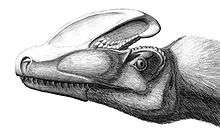Proceratosauridae
| Proceratosaurids Temporal range: Middle Jurassic - Early Cretaceous, 165–120 Ma | |
|---|---|
 | |
| Artist's impression of Guanlong wucaii | |
| Scientific classification | |
| Kingdom: | Animalia |
| Phylum: | Chordata |
| Class: | Reptilia |
| Clade: | Dinosauria |
| Order: | Saurischia |
| Suborder: | Theropoda |
| Superfamily: | †Tyrannosauroidea |
| Family: | †Proceratosauridae Rauhut, Milner & Moore-Fay, 2010 |
| Type species | |
| Megalosaurus bradleyi Woodward, 1910 | |
| Subgroups | |
Proceratosauridae is a family or clade of theropod dinosaurs from the Middle Jurassic to the Early Cretaceous.
Classification
The family belongs to the tyrannosaur lineage. It was first named in 2010 by Oliver Rauhut and colleagues in their re-evaluation of the type genus, Proceratosaurus. Their study supported the idea that Proceratosaurus is a coelurosaur, a tyrannosauroid, and most closely related to the Chinese tyrannosauroid Guanlong. They defined the clade containing these two dinosaurs as all theropods closer to Proceratosaurus than to Tyrannosaurus, Allosaurus, Compsognathus, Coelurus, Ornithomimus, or Deinonychus.[3] Later studies included the Russian Kileskus and the Chinese Sinotyrannus in the family.[4] Recently, Proceratosauridae has been found to include Proceratosaurus, Guanlong, Kileskus, Sinotyrannus, and the genera Stokesosaurus, Juratyrant, and Dilong previously recognized as non-proceratosaurid tyrannosauroids.[5][1] In their re-evaluation of Proceratosaurus, Rahut et al. stated that tooth taxa from the Late Jurassic and Early Cretaceous previously assigned to the dromaeosaurid subfamily Velociraptorinae may instead be Proceratosaurid in nature, due to the similarity between the teeth of the two groups and the fact that Velociraptorines are otherwise unknown from the fossil record until the Late Cretaceous. This would mean that Nuthetes and other dubious genera are potential Proceratosaurids.[3]
Below is the cladogram by Loewen et al. in 2013.[5]
| Proceratosauridae |
| |||||||||||||||||||||||||||
| |
See also
References
- 1 2 Juan D. Porfiri, Fernando E. Novas, Jorge O. Calvo, Federico L. Agnolín, Martín D. Ezcurra and Ignacio A. Cerda (2014). "Juvenile specimen of Megaraptor (Dinosauria, Theropoda) sheds light about tyrannosauroid radiation". Cretaceous Research. 51: 35–55. doi:10.1016/j.cretres.2014.04.007.
- ↑ Brusatte, S. L., and Carr, T. D. 2016. The phylogeny and evolutionary history of tyrannosauroid dinosaurs. Scientific Reports, 6, 20525. http://www.nature.com/articles/srep20252
- 1 2 Rauhut, O. W. M.; Milner, A. C.; Moore-Fay, S. (2010). "Cranial osteology and phylogenetic position of the theropod dinosaurProceratosaurus bradleyi(Woodward, 1910) from the Middle Jurassic of England". Zoological Journal of the Linnean Society. 158: 155. doi:10.1111/j.1096-3642.2009.00591.x.
- ↑ Brusatte, S.L.; Norell, M.A.; Carr, T.D.; Erickson, G.M.; Hutchinson, J.R.; Balanoff, A.M.; Bever, G.S.; Choiniere, J.N.; Makovicky, P.J.; and Xu, X. (2010). "Tyrannosaur paleobiology: new research on ancient exemplar organisms". Science. 329: 1481–1485. Bibcode:2010Sci...329.1481B. doi:10.1126/science.1193304. PMID 20847260.
- 1 2 Loewen, M.A.; Irmis, R.B.; Sertich, J.J.W.; Currie, P. J.; Sampson, S. D. (2013). Evans, David C, ed. "Tyrant Dinosaur Evolution Tracks the Rise and Fall of Late Cretaceous Oceans". PLoS ONE. 8 (11): e79420. doi:10.1371/journal.pone.0079420.
